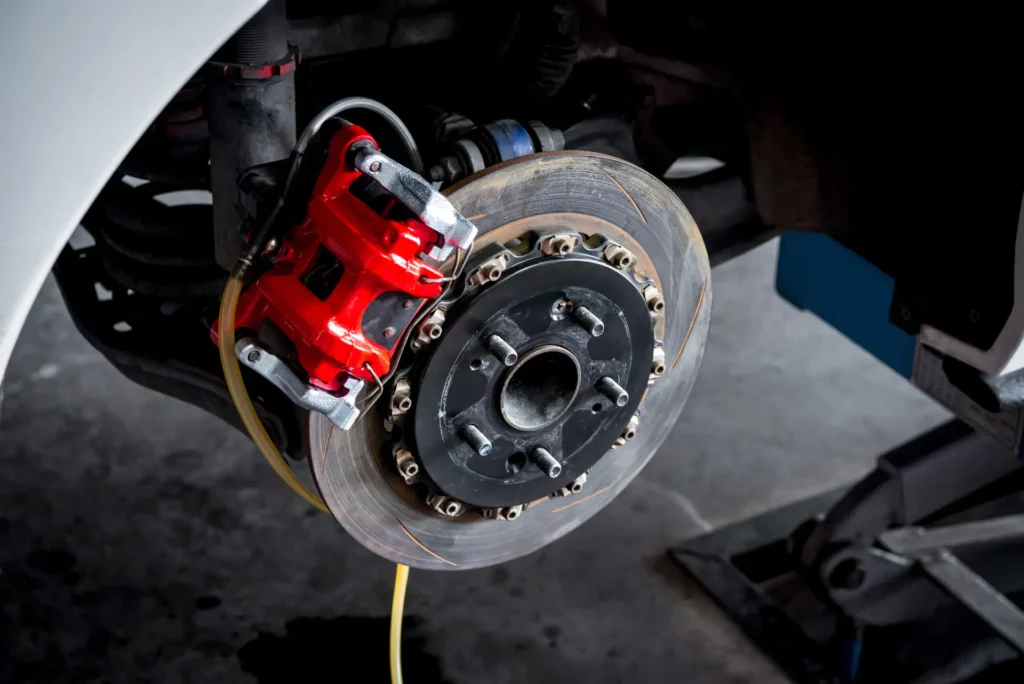Brake vs. Break
In the dance of the English language, where homophones glide across our conversations and writings, the pair brake vs. break often leads to a pause, a moment of confusion for many. Despite their identical pronunciation, these terms journey down divergent paths of meaning. “Brake” pertains to slowing or stopping motion, primarily in the context of vehicles—a mechanism or action designed to decelerate or halt. “Break,” however, unfolds into separation, division, or disruption, whether it’s a physical breakage or an interruption in continuity.
This distinction is not merely academic but pivotal in ensuring clarity and precision, from technical descriptions to everyday expressions. By delving into the nuances of brake vs. break, this guide aims to illuminate their correct usage, empowering readers to navigate these terms confidently and contribute to transparent and accurate communications.

Part 1: Understanding Brake vs. Break
Embarking on the journey to differentiate brake vs. break begins with establishing a solid foundation in their definitions, exploring their contexts, and recognizing their distinct roles in the English language. This foundational understanding enhances our communicative abilities and enriches our appreciation for the subtleties and precision language demands.
Definitions and Roles
Brake:
- As a noun, “brake” refers to a device to slow down or stop a vehicle or machine. It’s a mechanism integral to the safety and control of vehicles, from bicycles to cars and trains.
Example: “When she noticed the obstacle on the road, she instinctively hit the brake to avoid a collision.” - As a verb, “brake” describes the action of using this device — to slow down or halt movement.
Example: “He braked sharply at the stop sign, ensuring a complete stop before proceeding.”
Break:
- Primarily a verb, “break” encompasses various actions related to separation, damage, or disruption. It can signify the physical act of dividing into parts, an interruption in continuity, or the onset of a particular state or condition.
Example: “The glass vase fell and broke into a thousand pieces on the floor.” - Though less commonly, “break” can also function as a noun in contexts referring to an instance of breaking, a pause or interruption (as in a break from work), or a fortunate opportunity.
Example: “After hours of driving, they finally took a break at a roadside café.”
Grammatical Rules and Usage Guidelines
Distinguishing between brake vs. break is rooted in the understanding of their respective roles — “brake” as both a noun and verb related to stopping, and “break” as a versatile verb (and occasionally noun) associated with division or disruption:
- Contextual Clarity: Utilize “brake” when referring to mechanisms or actions to decelerate or stop vehicles. Use “break” to describe actions or events leading to separation, damage, or the interruption of continuity.
- Identifying the Focus: Assessing whether the discussion involves stopping/slowing down (brake) or separating/damaging (break) can guide the correct selection of these terms, ensuring communication remains clear and purposeful.
By laying a clear foundation for understanding brake vs. break, we pave the way for their practical use, allowing for communication that adeptly navigates the complexities of motion and disruption with clarity and precision.

Part 2: Using “Brake”
The term “brake” is instrumental when discussing the mechanisms and actions associated with controlling or halting motion. Its application is vital in everyday vehicle operation and complex machinery management, emphasizing safety and precision.
“Brake” for Slowing or Stopping
- Purpose and Application: “Brake” serves a dual role, describing both the devices designed to slow down or stop vehicles and the act of engaging these devices. Whether as a noun or verb, its usage is central to discussions on vehicle safety, operational instructions, and mechanical design.
Example (Noun): “Regular maintenance checks ensure that the vehicle’s brakes are in optimal condition.”
Example (Verb): “Learning when and how to brake smoothly is a crucial skill for new drivers.”
Everyday Contexts for “Brake”
“Brake” finds its relevance in several scenarios, all of which underscore the importance of control and safety in motion:
- Driving and Traffic Safety: Controlling vehicle speed is discussed in educational materials, driving instructions, and safety regulations.
Example: “The instructor emphasized the importance of braking gently to avoid skidding on icy roads.” - Mechanical and Engineering Descriptions: When detailing braking systems’ design, function, or maintenance within various machinery and vehicles.
Example: “The engineer explained the differences between disc and drum brakes in the workshop.”

Part 3: Using “Break”
Conversely, “break” delves into the action of causing separation, damage, or interruption. This versatile verb (and sometimes noun) extends beyond physical breakage to encompass metaphorical and emotional breaking forms, enriching its application across various contexts.
“Break” for Separation or Interruption
- Purpose and Application:” Break” articulates dividing something into parts, often suddenly or by force, or describes an interruption in a sequence or activity. It’s also used metaphorically to signify the onset of conditions or states.
Example: “The news broke his heart, leaving him to pick up the pieces of his shattered expectations.”
Differentiating Brake vs. Break
Distinguishing brake vs. break relies on understanding their application — “brake” as related to stopping/slowing down mechanisms and actions, and “break” as involving separation, damage, or interruption:
- Mechanism of Control vs. Act of Separation: While “brake” emphasizes control over motion, “break” spans a broader spectrum, covering physical breakage, emotional impacts, and disruptions in continuity.
Example (Break): “The committee decided to break for lunch after a long morning of discussions.”
Parts Two and Three explore the nuanced uses of brake vs. break, highlighting their appropriate application in contexts that range from safety and vehicle operation to emotional expressions and physical disruptions. By understanding specific scenarios and implications of each term, communicators can more accurately articulate motion control and separation concepts, enriching discourse with clarity and depth.

Part 4: Common Mistakes and How to Avoid Them
The homophonic nature of brake vs. break sets the stage for common mix-ups, leading to confusion, especially in written communication where the context might not suffice for clarification. Understanding and rectifying these mistakes are crucial for maintaining the clarity and precision of language.
Confusing Brake vs. Break
Mixing up “brake” and “break” can significantly alter the intended message, whether it pertains to halting motion or describing separation and damage.
- Strategy for Avoidance: Emphasize the conceptual distinction — remember that “brake” (with an ‘a’) relates to vehicles and stopping, while “break” (with an ‘e’) involves separation or damage. A mnemonic might be associating the ‘a’ in “brake” with “automobile” and the ‘e’ in “break” with “end” to denote separation.
Overgeneralization of Terms
Applying brake vs. break too broadly or in incorrect contexts can dilute the specificity of descriptions, particularly when detailing technical processes or physical actions.
- Clarification Tip: Consider the action or outcome you wish to convey. Is it related to stopping or controlling speed? Or does it pertain to causing or experiencing a fracture, division, or interruption? I want you to know that aligning your term choice with the precise action or outcome makes communication more straightforward.
Tips for Correct Usage
Cultivating an awareness of when to use enriches our communication, enabling us to navigate discussions involving control, safety, separation, and interruption with greater accuracy and effectiveness.
- Mindful Review: Practice reviewing your texts for brake vs. break to ensure you’ve selected the appropriate term based on the context.
- Practice with Scenarios: Create or engage with content that utilizes both terms, reinforcing their distinctions and solidifying your grasp of their proper usage.
- Seek Feedback: Sharing your use of brake vs. break with others for feedback can provide insights into applying these terms and help refine your understanding and usage.
Conclusion
Distinguishing between brake and break is more than a linguistic exercise; it’s a precision practice that reflects the depth and richness of English. By mastering the use of these terms, we not only avoid common pitfalls but also enhance our ability to communicate complex ideas and actions clearly and accurately. This exploration of brake vs. break reminds us of the importance of mindful language selection, encouraging us to approach our writing and speaking with intention and attentiveness.
Embracing Linguistic Precision
Our journey through the nuances of brake vs. break underscores the transformative power of precise language in enhancing understanding and expression. As we continue to navigate the intricacies of English, let us cherish and cultivate our capacity for discernment, enriching our dialogues and narratives with clarity and purpose.
The Path Forward
Challenge yourself to apply the insights gained from understanding the differences between brake vs. break in all your communications. Doing so contributes to a culture of clarity and precision that elevates our collective dialogues and enriches our shared language landscape. Explore further, question your assumptions, and celebrate the clarity and depth that come from meticulous attention to language.

Further Exploration
For those eager to dive deeper into the intricacies of English, countless resources await. From comprehensive grammar guides to interactive language learning platforms, the tools at your disposal are more accessible than ever. Engage with these materials, challenge yourself with new exercises, and remain curious and open to discovery. We offer a line of comprehensive grammar and punctuation courses and feature a mastery quiz bundle to cement your further mastery of grammar and punctuation. Feel free to access the endorsed resources below to enhance your learning experience.





